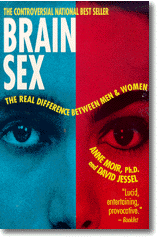
This book explains in detail the actions of hormones prior to birth - hormones that determine not only our obvious physical male vs. female attributes, but also the less visible but equally important brain structure and organization. In a nutshell, the mother contributes an 'X' chromosome and the male an W or a 'Y' chromosome; the W normally produces a female and the 'Y' a male. But another factor, hormones, also plays a role. A fetus will develop into a male only if male hormones are present, regardless of genetic makeup; a fetus will develop into a female only in the absence of male hormones. Sexual identity is determined at around six weeks when the male fetus, genetically XY, develops cells to produce male hormones which signal the body to not develop the feminine set of sexual equipment, but to start the development of embryonic male genitalia. A female fetus, genetically XX, produces no significant male hormones and continues development into a baby girl. Male hormones are also needed to develop a brain structured as a 'male brain.'
Although the book has many detailed explanations of male vs. female and how the real differences between them arise, one area that might be of specific interest to anyone questioning the area of sexuality is how the intervention of hormones can affect the unformed brain. If the male fetus has enough male hormones to trigger development of the male sex organs, but does not make the additional hormones to trigger formation of the male brain, the result can be a child born with a male body, but retaining the original 'female" brain. Similarly, if a female fetus is exposed to an accidental dose of male hormone in the womb, the result can be a male structured brain in a female body.
In addition to hormones produced prior to birth, there is also the subsequent rush of hormones as the child matures into an adult. It appears from the studies that hormones, or the absence thereof, play a large role in determining our sexual appearances, thinking processes, and mating preferences. Studies reveal that maleness (or femaleness, i.e., the lack of maleness) occurs in stages. Any abnormality in hormone levels at a stage can affect that stage of development, but the other stages may not be affected. Three stages which have been identified are: (1) the physical characteristic stage; (2) the hypothalamus (sometimes referred to as the 'mating center') development stage, which is thought to control sexual behavior in adult life; and (3) the 'gender-roles centers' of the brain which determine behaviors such as aggression, adventurism, sociability, etc. This theory explains how physical males with male mannerisms may be attracted to other males - supposedly a result of lessened or absent male hormone during stage two, but normal levels during stages one and three.
This abbreviated explanation of some theories presented in the book give an idea of how complex we are in terms of maleness and femaleness. I would strongly suggest that everyone read this book to gain insight into how and why males and females differ, and gain a better understanding of our fellow humans on this planet.